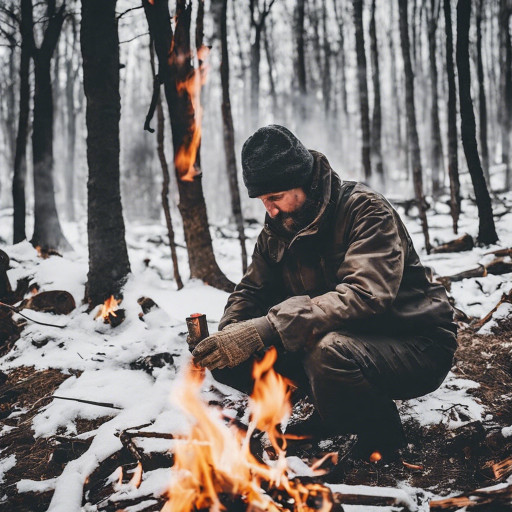Master Fire Ignition Techniques for Thriving in Extreme Cold Weather Conditions
The skill to ignite a fire in frigid temperatures goes beyond mere convenience; it is an essential survival tactic in the face of winter's harsh realities, characterized by bone-chilling cold and relentless winds. As a passionate survivalist, you understand that fire is crucial for maintaining body warmth, providing illumination, and enabling food preparation. However, starting a fire in icy conditions presents unique challenges that require tailored techniques and strategies. In this comprehensive guide, we will delve into the most effective and dependable methods for generating flames in cold weather, empowering you with the expertise and confidence necessary to overcome winter's grip and thrive in the wilderness.
Essential Gear for Successful Fire Starting in Cold Weather
Before you embark on your winter wilderness adventures, it is vital to gather the appropriate gear and supplies that can significantly increase your chances of survival. A well-curated fire-starting kit can be a game changer in navigating adverse weather conditions. Be sure to include these key items in your kit:

a. Firestarters: Reliable tools such as waterproof matches, storm-resistant lighters, and fire-starting rods are critical for ensuring ignition, even amid challenging elements like wind and moisture. Having a variety of fire-starting options will instill confidence, making it easier to ignite a fire regardless of the obstacles you face in the wild.
b. Dry Tinder: Finding dry tinder in cold environments can be quite a challenge. To tackle this issue, it’s advisable to pack highly combustible materials such as birch bark, fatwood shavings, and cotton balls infused with petroleum jelly. These items not only ignite rapidly but also substantially improve your chances of successfully starting a fire when temperatures dip below freezing.
c. Kindling: To create a strong foundation for your fire, gather dry sticks, twigs, and leaves. Ensure that these materials are completely dry; any moisture can hinder the ignition process and lead to frustration during your fire-starting attempts. Properly sourced kindling is essential for transitioning from tinder to a more robust fire that can provide warmth and cook food.
d. Fuel: Locating dry firewood in cold weather can be both exhausting and time-consuming. Therefore, having a sufficient stockpile of dry firewood prepared beforehand is crucial for maintaining a steady fire over an extended period. This preparation allows you to stay warm and comfortably cook food when temperatures plummet.
Strategically Choose the Best Fire Location for Optimal Performance
When the temperature drops, selecting the ideal location for your fire can greatly enhance its efficiency and effectiveness. Look for sheltered spots, such as rock formations or dense shrubs, to reduce exposure to biting winds. By positioning your fire near a natural windbreak, you not only minimize heat loss but also significantly increase the likelihood of sustaining a steady flame. Additionally, consider creating a small wind-resistant shelter using logs or a tarp to shield your fire from precipitation, helping to retain warmth and ultimately improving your safety and comfort in the outdoor elements.
Utilize Layering Techniques for a Persistent and Efficient Fire
A vital skill for successfully igniting a fire in cold conditions is mastering the layering technique for your materials. To build a fire that burns consistently, it is essential to utilize the three foundational layers: tinder, kindling, and fuel. Here’s a breakdown of each layer and its critical role in successful fire starting:
a. Tinder: The first layer, known as tinder, consists of materials that ignite quickly and easily. Opt for fine, dry substances like grass, paper, or the previously mentioned birch bark to ensure a strong initial flame. Having an ample supply of tinder is crucial for achieving successful ignition, especially in cold environments where conditions can be less than favorable.
b. Kindling: This second layer comprises small sticks and twigs that catch fire quickly while providing sustained heat. Gradually add kindling to your flame, ensuring sufficient space between pieces to promote airflow and encourage combustion. This careful step is vital for transitioning from small flames to a larger, more stable fire that can effectively generate warmth.
c. Fuel: Once you have established a consistent flame, gradually introduce larger pieces of firewood. Ensure that the wood is dry, as it will burn longer and produce more heat. Increase the size of the wood pieces incrementally, allowing the flames to strengthen before adding larger logs. This strategic approach to layering your fire fosters a stable and sustainable flame that can withstand the elements.
The technique of layering your fire creates a structured arrangement that enables the flames to expand and sustain themselves effectively. Always ensure you have an adequate supply of each component readily available to facilitate a smooth transition from tinder to fuel, thus ensuring a successful fire even in challenging cold conditions.
Enhance Fire-Starting Success with Proven Techniques and Aids
In icy weather, utilizing additional fire-starting aids can significantly improve your likelihood of successfully igniting a fire against the challenges presented by low temperatures. Here are some effective methods to consider integrating into your fire-starting approach:
a. Fatwood: Often referred to as nature’s firestarter, fatwood is resin-rich pine wood that ignites easily and burns with intense heat. You can gather these naturally occurring sticks from fallen pine trees or purchase them from outdoor supply stores. A few pieces of fatwood can dramatically boost your chances of successfully starting a fire in extremely cold conditions.
b. Alcohol-Based Hand Sanitizer: Surprisingly effective, alcohol-based hand sanitizer is highly flammable and works as a potent accelerant. A small amount applied to your tinder or kindling can facilitate quick ignition, even in damp weather conditions, simplifying the fire-starting process and ensuring you stay warm when it matters most.
c. Char Cloth: Char cloth is a specially treated fabric that ignites easily from sparks, making it an excellent tool for starting fires using flint and steel or a lighter in challenging situations. Its lightweight and portable nature makes it an ideal addition to your fire-starting kit, ensuring you are always prepared for an opportunity to create warmth.
Incorporating these fire-starting aids into your cold-weather toolkit can significantly enhance your chances of success when faced with particularly challenging conditions, allowing you to adapt effectively to your environment.
Explore Effective Fire Techniques Customized for Winter Conditions
As a dedicated survivalist, continuously refining your skills is crucial to achieving success in the wilderness. Here are two fire techniques that show exceptional effectiveness in cold weather conditions:
a. Swedish Torch: Also known as a Canadian Candle or Finnish Fire Log, the Swedish Torch is an incredibly efficient fire-starting method. This technique provides a stable and long-lasting flame, perfect for combating the chill of winter. To create a Swedish Torch, find a log about knee-height and cut several vertical slits along its length. Insert tinder into the slits and ignite it. The log will serve as a consistent fuel source, allowing the flame to endure for an extended period, ensuring warmth and safety.
b. Dakota Fire Hole: When faced with strong winds, the Dakota Fire Hole method proves to be highly effective. This technique involves digging a hole and tunneling horizontally underground to create an airflow vent. This design harnesses wind to enhance airflow, resulting in a more efficient fire that is less likely to be disrupted by gusts. Additionally, the Dakota Fire Hole method effectively reduces visible smoke while conserving fuel, making it an excellent choice for discreet fire building.
Regardless of the method you select, always prioritize safety and responsible fire management to minimize risks and ensure a successful fire-starting experience in the wilderness.
Successfully igniting a fire in cold weather necessitates careful planning and execution. By following these actionable steps—preparing a reliable fire-starting kit, selecting an appropriate location, mastering layering techniques, utilizing fire-starting aids, and adopting specific fire strategies—you will significantly improve your chances of success. Remember, practice is key to mastery, so consistently train to hone your skills and boost your confidence. With these essential tactics for igniting fires in freezing conditions at your disposal, you’ll be well-equipped to face even the harshest winters that nature throws your way. Stay warm, prioritize your safety, and keep the flames of survival burning bright!
The post Fire Starting Methods for Survivalists in Cold Weather appeared first on Survival Bite.
The Article Fire Starting Techniques for Cold Weather Survival Was Found On https://limitsofstrategy.com


The emphasis on mastering fire ignition techniques in extreme cold is undeniably crucial for anyone venturing into winter wilderness. I’ve had my share of chilly experiences in the backcountry where temperatures dipped well below freezing, and I can attest to the importance of having reliable methods for starting a fire.
You make a great point about the importance of mastering fire ignition in extreme cold. I can relate to those nerve-wracking moments when you’re trying to spark a flame with fingers numbed by the chill. I remember one trip where I had to rely on a ferro rod in a blizzard. It was a test of patience and technique, and it really highlighted how crucial it is to practice those skills in less pressing conditions.
I can definitely relate to those moments where every second counts in the cold. Relying on a ferro rod in a blizzard sounds like a real test of both skill and mental fortitude. I remember a trip where I had to use a similar technique, and it was definitely humbling — a reminder of how essential practice is, especially in conditions that push us to our limits.